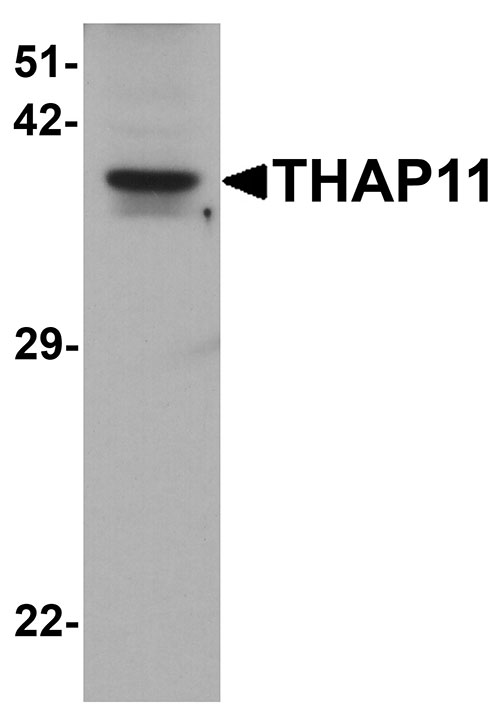THAP11 Antibody
- SPECIFICATION
- CITATIONS
- PROTOCOLS
- BACKGROUND

Application
| WB, E |
|---|---|
| Primary Accession | Q96EK4 |
| Other Accession | NP_065190, 40354197 |
| Reactivity | Human, Mouse, Rat |
| Host | Rabbit |
| Clonality | Polyclonal |
| Isotype | IgG |
| Calculated MW | Predicted: 35 kDa Observed: 38 kDa |
| Application Notes | THAP11 antibody can be used for detection of THAP11 by Western blot at 1 - 2 µg/ml. |
| Gene ID | 57215 |
|---|---|
| Target/Specificity | THAP11; THAP11 antibody is human, mouse and rat reactive. |
| Reconstitution & Storage | THAP11 antibody can be stored at 4℃ for three months and -20℃, stable for up to one year. |
| Precautions | THAP11 Antibody is for research use only and not for use in diagnostic or therapeutic procedures. |
| Name | THAP11 |
|---|---|
| Function | Transcription factor, which has both transcriptional activation and repression activities (PubMed:31905202). Also modulates chromatin accessibility (PubMed:38361031). In complex with HCFC1 and ZNF143, regulates the expression of several genes, including AP2S1, ESCO2, OPHN1, RBL1, UBXN8 and ZNF32 (PubMed:26416877). May regulate the expression of genes that encode both cytoplasmic and mitochondrial ribosomal proteins (By similarity). Required for normal mitochondrial development and function. Regulates mitochondrial gene expression, including that of components of the electron transport chain (By similarity). Involved in the maintainance of pluripotency in early embryonic cells, possibly through its action on mitochondrial maturation which is required to meet high energy demands of these cells (By similarity). Required for early development of retina, preventing premature exit of retinal progenitor cells from the cell cycle. This effect may also be mediated by its action on mitochondria (By similarity). Through the regulation of MMACHC gene expression, controls cobalamin metabolism (PubMed:28449119, PubMed:31905202). Required for normal brain development and neural precursor differentiation (By similarity). Involved in cell growth (PubMed:31905202). |
| Cellular Location | Nucleus. Cytoplasm Note=In oocytes, detected in the ooplasm, without evidence of its presence in the nucleus (By similarity). Found in the nucleus of undifferentiated embryonic stem cells (PubMed:18585351). Evenly distributed between nucleus and cytoplasm in skin fibroblasts (PubMed:37148549). {ECO:0000250|UniProtKB:Q9JJD0, ECO:0000269|PubMed:18585351, ECO:0000269|PubMed:37148549} |
| Tissue Location | Expressed in skin fibroblasts. |

Thousands of laboratories across the world have published research that depended on the performance of antibodies from Abcepta to advance their research. Check out links to articles that cite our products in major peer-reviewed journals, organized by research category.
info@abcepta.com, and receive a free "I Love Antibodies" mug.
Provided below are standard protocols that you may find useful for product applications.
Background
The THAP domain-contining protein 11 (THAP11), also known as Ronin, is an essential factor involved in embryonic stem (ES) cell pluripotency and cell growth (1). THAP 11 contains a THAP domain, a conserved DNA-binding domain common to many proteins associated with chromatin modification and gene expression silencing, and has striking similarity to the site-specific DNA-binding domain (DBD) of Drosophila P element transposases (2). THAP11 can also negatively regulate CD44 v6 expression through its interaction with the poly(rC) binding protein PCBP1 (3).
References
Dejosez M, Krumenacker JS, Zitur LJ, et al. Ronin is essential for embryogenesis and the pluripotency of mouse ES cells. Cell 2008; 133:1162-74.
Roussigne M, Kossida S, Lavigne AC, et al. The THAP domain: a novel protein motif with similarity to the DNA-binding domain of P element transposase. Trends Biochem. Sci. 2003; 28:66-9.
Lian WX, Yin RH, Kong XZ, et al. THAP11, a novel binding protein of PCBP1, negatively regulates CD44 alternative splicing and cell invasion in a human hepatoma cell line. FEBS Lett. 2012; 586:1431-8.
If you have used an Abcepta product and would like to share how it has performed, please click on the "Submit Review" button and provide the requested information. Our staff will examine and post your review and contact you if needed.
If you have any additional inquiries please email technical services at tech@abcepta.com.













 Foundational characteristics of cancer include proliferation, angiogenesis, migration, evasion of apoptosis, and cellular immortality. Find key markers for these cellular processes and antibodies to detect them.
Foundational characteristics of cancer include proliferation, angiogenesis, migration, evasion of apoptosis, and cellular immortality. Find key markers for these cellular processes and antibodies to detect them. The SUMOplot™ Analysis Program predicts and scores sumoylation sites in your protein. SUMOylation is a post-translational modification involved in various cellular processes, such as nuclear-cytosolic transport, transcriptional regulation, apoptosis, protein stability, response to stress, and progression through the cell cycle.
The SUMOplot™ Analysis Program predicts and scores sumoylation sites in your protein. SUMOylation is a post-translational modification involved in various cellular processes, such as nuclear-cytosolic transport, transcriptional regulation, apoptosis, protein stability, response to stress, and progression through the cell cycle. The Autophagy Receptor Motif Plotter predicts and scores autophagy receptor binding sites in your protein. Identifying proteins connected to this pathway is critical to understanding the role of autophagy in physiological as well as pathological processes such as development, differentiation, neurodegenerative diseases, stress, infection, and cancer.
The Autophagy Receptor Motif Plotter predicts and scores autophagy receptor binding sites in your protein. Identifying proteins connected to this pathway is critical to understanding the role of autophagy in physiological as well as pathological processes such as development, differentiation, neurodegenerative diseases, stress, infection, and cancer.


